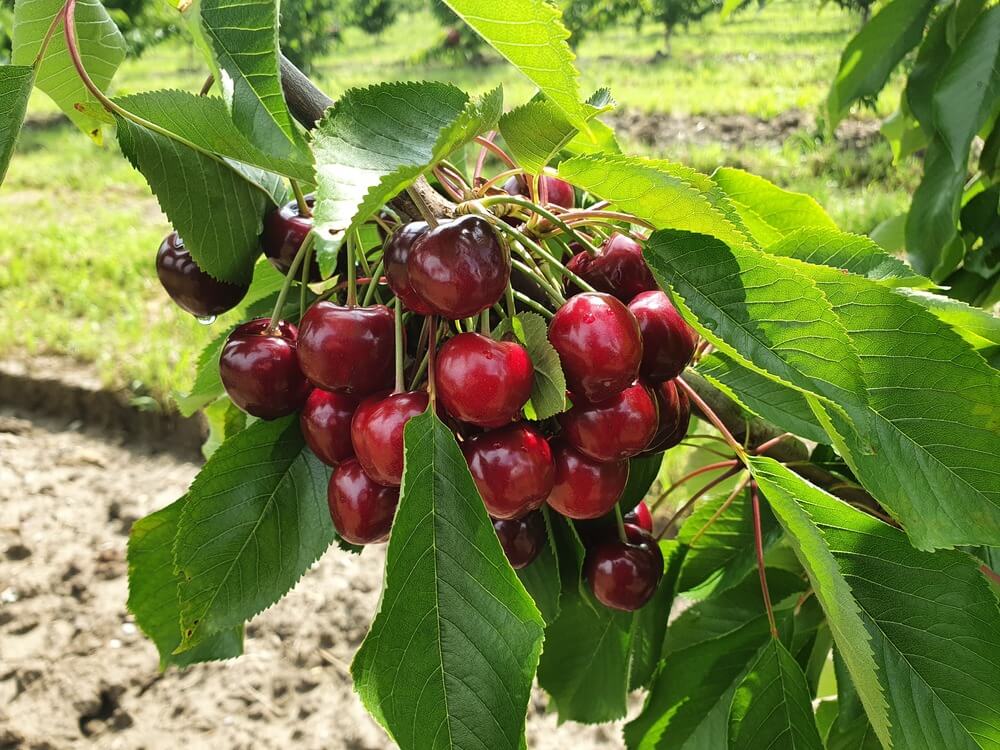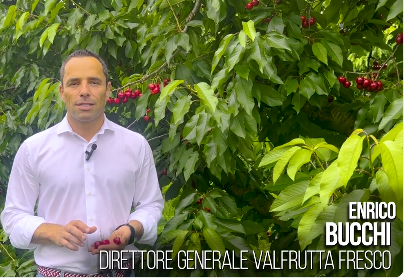The Drosophila suzukii has been present in France since 2010 and is responsible for significant damage, particularly to cherries. Various solutions have been extensively tested to combat this pest. Some techniques can already be used, while others are interesting to explore.
Anti-insect nets: effective but expensive.
Tests conducted at CTIFL in Balandran and La Tapy since 2013 demonstrate that anti-insect nets on fully sealed plots have excellent efficacy, with less than 1% damage to the fruits. However, the investment is high, ranging from 50,000 to 100,000 euros/ha depending on the type of installation (single row or single plot) and the labor required.
The investment can be profitable thanks to a regular yield in terms of quantity and quality. It is also necessary to review the method of management under the net (high-density trellis orchard, for example). However, the La Tapy station is also experimenting with single-row and single-plot nets on existing orchards in the form of a goblet. These nets are also effective against suzukii. However, caution must be exercised regarding moniliosis in plots with single-row nets.
Perimeter net
Eighteen trials were conducted in various experimental stations in France on this net with different pest control strategies. Only 4 trials resulted in an economic return for this technique. The net alone is not sufficient to effectively combat the flies. There are still many issues to resolve with this technique, and a project led by CTIFL has just started in 2024 with new trials.
Mass traps
Various types of traps (homemade and commercial) have been tested with different arrangements (different densities, inline and perimeter traps). The results have been mixed. On the other hand, the timing of trap placement seems very important. To be effective, traps must be placed early, at least 45 days before harvest.
Despite the high number of individuals caught by the traps, the results are highly variable. This type of control represents a significant purchase cost. Additionally, the traps must be removed and replaced each year. Trials are also underway on the capture period with mass traps placed from the autumn of year N-1 to the flowering of year N to catch individuals that have survived the winter and constitute the founders of the population for the following year.
Release of parasitoids
The INRAE has identified an exotic parasitic micro-wasp of D. suzukii, Ganasis cf. brasiliensis. Following studies on this parasitoid, it has been introduced in various plots in France. Trials are currently ongoing.
Microinjections
This new technique involves injecting an insecticide into the trunk of trees, which circulates through the vascular system and is distributed to target organs. CTIFL has been working on this method since 2020. Injection parameters such as needle length, number of injection points, efficacy of the active ingredient, and dosage need to be determined. Some active ingredients work better than others.
Biocontrol products: numerous trials have also been conducted on the efficacy of biocontrols against flies. Products based on paraffin oil, azadirachtin, or physical barriers made of clay or talc have been tested. The efficacy of the commercial products tested has not been demonstrated this year. Trials will be repeated on other commercial products or new specialties in the coming years.
The "attract and kill" technique
An attractant was tested, but the results were not consistent, so this technique will need to be tested again in 2024 and 2025.
Repellents
In 2023, 3 repellents not registered were tested to integrate the grower's strategy. Results were obtained on only 2 of them. The efficacy seems promising, and new trials should be repeated.
SIT (Sterile Insect Technique)
This technique involves the release of a large number of sterilized (with X-rays or gamma rays) males of the species to be controlled in plots. SIT is used on dozens of insect species worldwide, but rarely in Europe. Its efficacy has been demonstrated on all these species.
SIT has been under development for D. suzukii since 2015 in France and Austria, and more recently in Argentina, Chile, and Canada. The results are very promising, and sterilization and rearing on a medium scale have been achieved. Now we need to move to large-scale rearing and develop the logistics and release parameters.
The drawback of SIT is that it targets only one species. Another important problem is that the female continues to lay eggs (non-viable eggs) and thus causes damage to the fruit (albeit less severe). We need to rethink our protection methods to make the best use of the potential of this technique. Especially since the regulations on the release of sterile insects are now clear and no more restrictive than those for other biocontrol releases.
Bactrocera dorsalis
This oriental fruit fly has been present on Reunion Island since 2017. It is highly polyphagous and has become the dominant species on most host plants in low-altitude areas. It causes considerable damage to various crops, particularly mangoes.
The sterile insect technique (SIT) is being studied on Reunion Island and also in Thailand, for example. This technique takes a long time to develop, and many parameters are being studied. Models have been created to study these parameters. SIT must be combined with other control techniques.
For example, the number of females can be reduced by capture. This involves attracting them with specific substances. Kairomones, volatile compounds emitted by fruits or plants, are being studied. The study is conducted by CIRAD on Reunion Island.
Recently, scientists on Reunion Island also demonstrated that a substance emitted by a specific fungus, naturally present on Passiflora edulis fruits, is a powerful attractant for male B. dorsalis. Once attracted, they can be captured and destroyed.
With the recurring incursions of B. dorsalis in Europe and particularly in mainland France since 2019, the risk of establishment is not negligible. The development of SIT could take on another dimension, especially to eradicate the species when populations are still small at the beginning of an invasion.
B. dorsalis, B. zonata, and Ceratitis capitata
These three species of fruit flies represent a serious threat to horticultural production in Europe: the Mediterranean fruit fly (Ceratitis capitata), the oriental fruit fly (Bactrocera dorsalis), and the peach fruit fly (Bactrocera zonata).
The Mediterranean fruit fly is already present in Europe and France, while the other two have not yet established themselves. However, they are often present in Europe through the importation of infested fruit.
A European project (FF-IPM) has been launched to develop prevention and early detection approaches that can be combined with integrated pest management approaches against these emerging fruit fly species, particularly for off-season fruit production.
This project has generated new knowledge and several tools and services (models, decision support tools, etc.) for the prevention and early detection of these fruit flies.
Come si distinguono queste 3 specie?
- B. dorsalis: Due to its size and coloration, the adult cannot be confused with other fruit flies present in France or Europe. The genus Bactrocera in Europe is represented only by the olive fly, Bactrocera oleae (Gmelin), which is smaller (4-5 mm) and lacks yellow stripes or spots on the thorax. The adult is a large fly (7-8 mm long) with considerable variability in thoracic color, ranging from brown to black. The thorax features yellow spots and stripes.
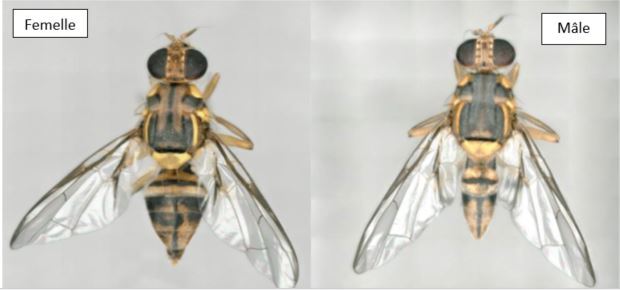 Image 1: B. dorsalis, female specimen (left) and male (right).
Image 1: B. dorsalis, female specimen (left) and male (right).
- Bactrocera dorsalis and zonata: Both species are large flies (7-8 mm long), brownish in color, with long antennae, yellow legs, and transparent wings. They resemble wasps and are difficult to distinguish. One way to differentiate them is to observe the pattern on the thorax: adults (flies) lay eggs in fruits, and the three species are indistinguishable at the larval stage. Major host plants include peaches, mandarins, and oranges.
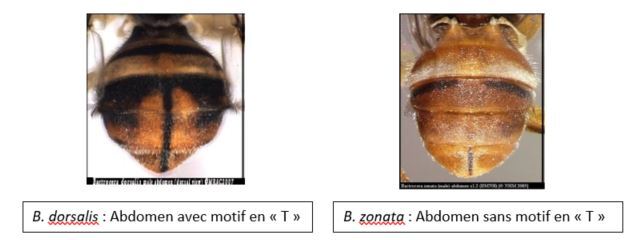 Image 2.
Image 2.
Depending on temperature conditions, the cycle of B. dorsalis occurs over two or more weeks (eggs: 1-3 days and three larval stages: 9 days to several weeks). Larvae develop at temperatures above 13°C. Mating occurs in the soil around the infested plant.
Adults are more resistant to cold and can tolerate temperatures down to 2°C (torpor threshold). They normally do not survive winter in mainland France but can survive in sheltered areas in Corsica. When caught in traps, only males are attracted to methyl eugenol. They are not attracted to specific attractants for Ceratitis capitata. No attractants are known for females.
B. dorsalis and B. zonata are listed as Quarantine Organisms of Priority (OQP) for all continents where they are not native. If suspected, contact SRAL or FREDON in your region. Prompt notification can contribute to their eradication.
Remember that Ceratitis capitata is one of the main threats in our department, especially on apricots and peaches, but also on apples, persimmons, kiwis, citrus fruits, etc.
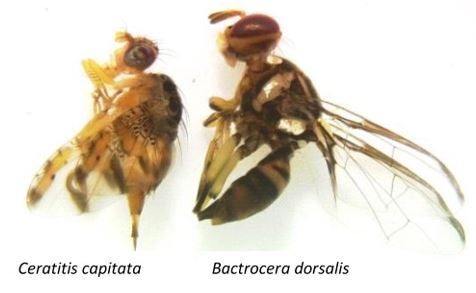 Image 3: B. dorsalis (right) is larger in size compared to C. capitata (left).
Image 3: B. dorsalis (right) is larger in size compared to C. capitata (left).
The year 2023 was characterized by very high pressure from this insect. Captures were relatively early, towards the end of June. A steady increase in populations was observed. Trap surveys indicated a high presence of fruit flies across almost the entire department, with some geographical areas more affected than others (especially Aspres).
Initial damage was observed on apricots during the Royal Roussillon harvest.
On peaches, the extent of damage is difficult to quantify depending on the sector, maturity of the plots, and control measures implemented. The presence of mass traps (with Decis, Ceratipack, Vio-trap, etc.) in most plots, combined with insecticidal (biological and conventional) treatments, was not sufficient to prevent damage.
The number of traps at the end of the season was very high. Damage to fruits at harvest time or within a few days of storage steadily increased throughout the season, especially for yellow peaches. The risk remains very high for other fruit species maturing in late summer and autumn (apples, persimmons, clementines, etc.). This insect, previously confined to the coast, seems to have adapted to the climate throughout the department.
Control Strategy (Source: Fiche Sud Arbo 2017).
- Prophylactic measures: destroy unharvested fruits. Unharvested and fallen fruits should be removed, wrapped, and crushed to prevent new punctures and pupae in the soil.
- Chemical control: few commercial specialties are authorized against this parasite. Their effectiveness is limited in case of high pressure.
The two described techniques can be used in both organic and conventional agriculture. Before applying these methods, consider the history of the plot, especially areas where initial damage has appeared.
- Mass trap: two traps are available, the Decis Trap Med and the Ceratipack. The attractants used in these traps are the same; the only difference is the type of trap. Captured flies are then killed by the insecticide present in the traps (deltamethrin).
The principle is to place a large number of traps (50 to 80 per hectare) in the plots to capture a large number of flies and significantly reduce populations. The effectiveness of this technique increases with the treated area. Traps should be placed approximately 45 days before harvest. Traps are also used to detect the onset of Ceratitis flights.
There are therefore 2 strategies:
- around the perimeter of the plots: the strategy is to surround the plot with traps to prevent flies from entering from outside the orchard. Trap density varies from 20 to 30 per hectare. This technique is less expensive, but all traps must be collected twice a week, so the number of traps can be increased depending on insect pressure. This technique is reserved for plots where pressure remains moderate.
- uniform distribution: it is necessary to place from 50 to 80 traps/ha and collect some traps once a week. This technique was developed due to the increase in fruit fly populations and the limited choice of available chemical solutions for spraying.
Attract and Kill
A specialty is authorized: Magnet Med. It is a single-use insecticidal trap consisting of a plate and an integrated hook specially designed to attach to tree branches. The fly is attracted by food attractants, lands on the trap, comes into contact with the insecticide, and dies before it can lay eggs in a fruit.
From 50 to 75 traps/ha are used, depending on the crop and pressure. Like mass trapping, this technique requires monitoring. It is recommended to place 1 or 2 Ceratipack or Decis Trap traps on each side of the plot (depending on size) and perform weekly readings.
The advantage of these biocontrol methods is that they can be used in all orchards and do not leave residues on fruits. With a single application and an attraction duration of at least 4 months, they are not subject to pre-harvest or re-entry periods. However, these methods require regular monitoring and can be complemented by insecticidal treatments to increase effectiveness.
Source: Chambre d'Agriculture Pyrénées-Orientales
Images: Chambre d'Agriculture Pyrénées-Orientales
Cherry Times - All rights reserved








